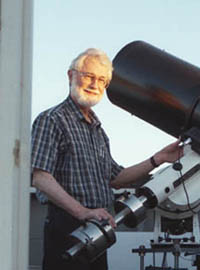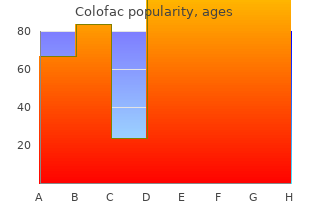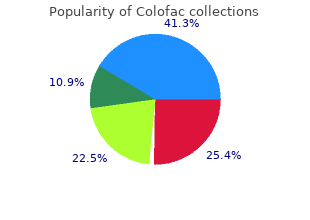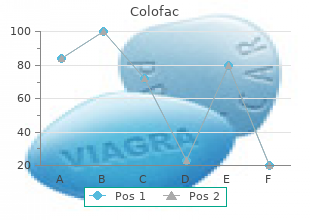Colofac
"Purchase colofac 135 mg on-line, treatment 197 107 blood pressure."
By: Bertram G. Katzung MD, PhD
- Professor Emeritus, Department of Cellular & Molecular Pharmacology, University of California, San Francisco

http://cmp.ucsf.edu/faculty/bertram-katzung
Four injection sites are required colofac 135mg otc, and anesthe- • Aspirate and confirm that no blood returns generic colofac 135mg mastercard, and then sia is fanned peripherally in a ring-block fashion inject 2 to 3 mL of local anesthetic generic 135mg colofac visa. Withdraw slightly buy colofac 135 mg with amex, and inject another 1 to – Radial nerve 2 mL laterally on each side of the infraorbital foramen. Inject at the wrist crease • Withdraw the needle slightly, and redirect the needle to (red dot) between the flexor carpi radialis (A) and the the dorsal surface, and inject 0. The anesthetic is injected along the side – Needle is redirected in a fan-shaped pattern from of the digit as the needle is withdrawn. Feel for the posterior tibial artery • Forehead: below the frontalis muscle, between the pulsation (the nerve is just behind the artery) 2 superior temporal lines laterally – Needle is inserted midway between the medial • Nose: below the nasalis muscle malleolus anteriorly and the Achilles tendon • Disadvantages posteriorly. Raise a wheal at this site, and advance – Too deep: may injure vital structures (i. Nerve becomes even more superficial as it travels obliquely up toward the corner of the mouth. As long as one stays above the lip depressor muscles, however, the nerve will not be injured There is great variation, however, in where the nerve lies relative to the mandibular rim. Several other nerves are at risk in this anatomic location: • Spinal accessory (motor) • Greater auricular (sensory) • Transverse cervical (sensory) activation time, surgical technique (orientation of • Complete electrical circuit: needs 3 basic system electrode), and tissue impedance components, along with the patient—a power unit, an • Definition of terms active electrode, and a dispersive or return electrode • Electric current: flow of electrons during a period of • Active electrode: i. The more rapidly these 2 tines, which results in substantially less tissue the sine waves return to baseline, the more damped damage than in monopolar devices. Erb point, also known current flow as “area nervosa” can be identified by drawing a line • the electrosurgery is not directly over the cardiac device between the mastoid and jaw angle (blue line), and – Magnet device: placed over a cardiac pacemaker then drawing a line (black line) vertically down from the to inhibit it during the procedure. Pacemaker then midpoint of the first line to the posterior border of the must be interrogated postoperatively to ensure sternocleidomastoid muscle. Motor nerves at risk and resuscitation abilities during the procedure include the supraclavicular branches of the cervical plexus and the spinal accessory nerve. Owing to direct tissue contact, charring depth may be slightly deeper in electrodesiccation than in electrofulguration †Both electrodesiccation and electrofulguration cause superficial coagulation and have hemostatic effects. Hairs may be isopropyl alcohol and use nonsterile gloves trimmed but not shaved • More invasive procedures (i. The American Heart Association target, antiseptics have multiple targets and a broader states that antibiotics may be given up to 2 hours after spectrum of activity, which include bacteria, fungi, the procedure if it was not given preoperatively. Or other first- or second-generation oral cephalosporin in equivalent adult or pediatric dosage. Cephalosporins should not be used in an individual with a history of anaphylaxis, angioedema, or urticaria with penicillins or ampicilllin. Avoid second • Transfer of tissue (donor site) with its attached intention if bare bone, tendon, or neurovascular vascular supply into a wound defect (recipient site) for structures are exposed closure – Large defects will also heal well if superficial. Due • Eponyms should generally be avoided to their bulk and high metabolic demand, composite • Most flaps in cutaneous surgery are local (adjacent and grafts survive poorly if sized greater than 1. Rotation and trans- the left and right upper cutaneous lips, the philtrum, position flaps have in common a pivoting or arclike and the mucosal lip). In general, repairs within a sub- motion, whereas advancement flaps have a sliding unit or incisions placed at junctions of subunits yield motion in straight lines (Fig. Comet flap Interpolation flap subtypes with advancement Transposition subtype movement 1. Retroauricular-staged flap (This is a staged Dufourmental) flap that has a linear movement. Webster 30 degree Note or Banner flap it may also be classified as a transposition (Fig. Flap lines are move across and over an intervening segment of straight and angles are often perpendicular at right angles normal skin to close the defect. Flap lines are often at • Rotation flap: a random- or axial-pattern flap where acute angles (< 90 degrees) the donor tissue pivots in a curved or arclike motion. Primary Bürow (black triangle) closes primary defect and secondary Bürow (yellow triangle) closes secondary defect. A cheek interpolation flap is a staged flap no longer be used for V-Y flaps performed in derma- (requires 2 or more stages) but it is not an axial tologic surgery. Its vascular supply comes from non-named named axial artery flaps with substantial myocutane- branches of the angular artery but the artery itself is ous pedicles that are tunneled to their defects. Similarly, a postauricular staged • Backcut: a relaxing incision on the far end of a rota- flap is an interpolation flap but not an axial flap tion curve to release lateral flap restraints and facilitate • Abbe (lip-switch) flap (Fig. Its pedicle is either scar’s length (makes scar longer, more angulated, zigzag the inferior (most common) or superior labial artery. Whereas the Abbe flap is a 2-staged repair, the change in direction depends on the degree of trans- Abbe Estlander flap requires only 1 stage position of the Z-plasty. Where do the internal carotid and external carotid arter- prophylaxis Indication ies not anastamose? The Z-plasty is a form of transposition fap that is ofen used for scar revision for scar length and chang- 13. It alters the change (redirection) of antibiotics preoperatively to prevent endocarditis? Adult male with prominent mitral valve regurgitation to lengthening and breaking up of a scar into multiple B. Student with cardiac transplantation and mitral valve the degree of transposition of the Z-plasty. Prilocaine is metabolized to ortho-toluidine, Answers an oxiding agent capable of converting hemoglobin to 1.
The findings of this meta-analysis showed that vas- cular injuries are prevented almost entirely by the open the Swiss Association for Laparoscopic and technique (4 colofac 135mg on-line. When all contrast to findings in general surgery publications by open laparoscopies were excluded from the analysis cheap colofac 135mg fast delivery, the Sigman et al cheap colofac 135mg with amex. In addition discount 135mg colofac fast delivery, they pointed A multicentre questionnaire survey of general surgeons out that gynaecologists may have more experience than (57% responding) reported a relatively high incidence of general surgeons with laparoscopic surgery. This may be influenced by patient selection bias, as open procedures may be more In clinical trials that compared closed and open entry tech- likely to be chosen for patients who have had previous niques, the complication rates were 0. Another potential bias is that the num- the closed and open techniques, respectively. The bowel and major vessel They found that bowel injuries were no less common with injury rates were 0. They concluded that open laparos- injuries of the small bowel in four patients, two with delayed copy does not reduce the risk of major complications dur- 104 recognition and death, and with retroperitoneal vessels in ing laparoscopic access. In the remaining 10 patients, there were four methods used by general surgeons and gynaecologists to instances of colon injuries, three of abdominal wall vessel establish access for laparoscopic surgery. They noted that laceration, and one each of liver, urinary bladder, or mesenteric vessel injury. The result was a clear trend and 13% to 50% of vascular injuries are undiagnosed at the towards a reduced risk of major complications in unselected time of surgery. Meta-analysis of prospective, non-randomized studies of bowel injuries following optical trocar insertions. Instead of dissecting down at frequency of multiple attempts or ease of insertion. Laparo- tional bowel injuries were encountered with the direct scopic entry is initiated with only one blind step (trocar) trocar entry (0. The direct entry method is faster than any other method of Hill and Maher perforated the omentum with the direct entry106,107; however, it is the least performed laparoscopic trocar in 26 of 542 patients (4. However, direct entry cations with direct trocar entry than with the Veress needle. Reusable trocars are not subject to a standardized initial insufflation was safer than direct trocar insertion; the frequency of sharpening14,27; this and the strength required use of disposable trocars did not improve the safety of the to adequately elevate the abdominal wall and to make a con- procedure. They found that 10 out of 36 higher proportion of women than men experienced diffi- (28%) serious injuries and two out of seven (29%) deaths culty inserting both the primary and secondary trocars. When difficulty was associated with the primary trocar, the correlation was even more striking Marret et al. Half of the trocars used were disposable and this type of so-called safety trocar was Recommendation responsible for half of the large blood vessel injuries. Direct insertion of the trocar is associated with less deaths, 26 (81%) resulted from visceral injuries, and 6 insufflation-related complications such as gas embo- (19%) resulted from vascular injuries. Eighty-seven percent lism, and it is a faster technique than the Veress needle of deaths from vascular injuries involved the use of dispos- technique. As the shield enters the trocars cannot prevent serious injuries during laparoscopic access. There were few reports in which a safety-shield mal- these trocars were intended to prevent the sharp tip from function was alleged to have contributed and even fewer in injuring intra-abdominal contents. There were no injuries from reusable trocars, unprotected as it enters the abdominal cavity. The authors point out that the lack of reusable trocar injuries In the presence of pneumoperitoneum, disposable shielded reflects the popularity of disposable devices in the United trocars have been shown to require half the force needed 31 States. Their application recruits sig- nificant axial thrust through the surgeon’s dominant upper Recommendation body muscles to transect abdominal myofascial layers. Shielded trocars may be used in an effort to decrease Endopath Optiview optical trocar entry injuries. There is no evidence that they result in fewer visceral and vascular injuries during laparoscopic the Endopath Optiview optical trocar comprises a hol- access. A 5 mm incision is then made the radially expanding access system (Step, InnerDyne, with a scalpel to accommodate the visual trocar’s pointed tip. The abdomen may first be insufflated using the placed at 3 and 9 o’clock and held with snaps. The needle is removed, and the sleeve acts as then divided between the stay sutures over a length of a tract through the abdominal wall that can be dilated up to approximately 5 mm. During insertion, the stay sutures are 12 mm by inserting a blunt obturator with a twisting 21,121,122 pulled to lift the abdominal wall against the advancing tra- motion. The force required to push this trocar jectory and facilitate proper port site closure at the end of through the abdomen in pigs is 14. Alternatively, the assistant may grasp the forces of 4 to 6 kg needed for disposable trocars. The cascade of generated entry operative pain and more patient satisfaction with the images displayed on the monitor demonstrates level of radially expanding device than with the conventional trocar 123–126 penetration. Some surgeons advocate use of visual trocars during gasless Advantages of this system include elimination of sharp laparoscopy, in which abdominal wall lifting devices are trocars, application of radial force, stabilization of the can- used to tent the abdominal wall before the primary visual nula’s position (cannula does not slide in and out), avoid- trocar is inserted under visual control. Experience with such ance of injury to abdominal wall vessels, and elimination of 128 methods is limited, and large-scale studies are lacking. The retention of the push-through trocar design necessi- Recommendation tates considerable axial force to propel the trajectory, with 12. Radially expanding trocars are not recommended as no mechanism to offset overshoot.

Histology shows an infiltrate of the lamina propria in the antrum or body by plasma cells buy colofac 135 mg without prescription, lymphocytes and rare neutrophils discount colofac 135mg online, and a marked intraepithelial infiltrate with T lymphocytes order colofac 135mg amex. Endoscopy may show pylori obstruction order 135mg colofac fast delivery, prominent gastric folds (Table 3), nodularity or ulceration, and histology is characterized by eosinophilic infiltration (> 20 per high power field), eosinophilic pit abscesses, necrosis and epithelial regeneration. Ménétrier’s disease is associated with protein- losing gastropathy and hypochlorhydria whereas hyperplastic, hypersecretory gastropathy is associated with increased or normal acid secretion and hyper- plasia of the parietal and chief cells, with or without protein loss. Endoscopy, in both cases, typically shows irregular hypertrophic folds involving the body of the stomach, although there is a polypoid variant that resembles multiple hyperplastic gastric polyps. The characteristic histological features are foveolar hyperplasia with cystic dilation; inflammatory infiltrates may be present, as in hypertrophic lymphocytic gastritis, but this is variable. Gastric resection for refractory protein loss, hemorrhage or obstruction is a last resort. Endoscopy typically shows multiple exophytic gastric masses, which on sec- tion reveal multiple cysts. At histology, foveolar hyperplasia is accompanied by cystic glands that extend through the muscularis mucosae into the submucosa and muscularis propria. It may be associated with chronic atrophic gastritis, hyperplasia or primary gastric stump cancer after surgery. An ulcer is distinguished from an erosion by its penetration of the muscularis mucosa or the muscular coating of the gastric or duodenal wall. Peptic ulcer diseases result from an imbalance between defensive mechanisms of the mucosa and aggressive factors. Smooth mucosal folds radiating from the edge of the crater (arrows) in a regular fashion are a pathognomonic sign of a benign gastric ulcer. Given the multiple processes that control acid and pepsin secretion and defence and repair of the gastroduodenal mucosa, it is likely that the cause of ulceration differs between individuals. Acid and pepsin appear to be necessary but not sufficient ingredients in the ulcerative process. It is clear that the majority of gastric ulcers (Figures 8, 9) and a substantial number of duodenal ulcers (Figures 10, 11, 12) do not have increased gastric acid secretion. Peptic ulcers usually occur at or near mucosal transitional zones, areas that are particularly vulnerable to the deleterious effects of acid, pepsin, bile and pancreatic enzymes. Gastric ulcers are most commonly found on the lesser curvature, near the junction of acid-producing parietal cells and the antral mucosa, extending to an area 2–3 cm above the pylorus. Duodenal ulcers are usually found in the duodenal bulb, the pyloric channel or prepyloric area. Other peptic ulcers may occur in the esophagus, gallbladder (rarely, with ectopic gastric mucosa), and Meckel’s diverticulum. It is not known whether the bacteria or the accompanying inflammation is the more important factor in the pathophysiology. The surrounding inflammatory process has considerably distorted the normal bulbar configuration of the proximal duodenum. The net result is an increase in expression of various adhesion molecules, leading to neutrophil adherence to the vascular endothelium. Gastric ulcer often occurs with decreased acid-peptic activity, suggesting that mucosal defensive impairments are more important (Figure 16). Other evidence suggests that it may increase the risk of both ulcers and bleeding complications in patients taking these drugs. Therefore, it is still necessary to seriously consider the pathophysiology and the management of the ulcers, which may exist after elimination of H. Studies of twins show greater concordance among identical than among fraternal twins. Interestingly, very few patients who develop serious complications have antecedent dyspeptic symptoms. This was the first example of a common chronic bacterial infection usually acquired in childhood causing disease much later in life. In the future, many other diseases are likely to be linked to chronic infections but for now H. Although regular screening is not warranted in either case, minor symptoms should be promptly and thoroughly investigated. Ran- domized controlled trial data proves that this association is causal but this does not mean that 90-95% of all duodenal ulcers are due to H. As the prevalence in the general population is also high, a few ulcers that are not due to H. It is estimated that the Stomach and Duodenum 163 about 75% of all peptic ulcers are attributable to H. The reasons for this are not fully understood but relate to a combination of environmental, host and bacterial factors. The most well characterized is the cytotoxin associated gene (cagA) and the vacuolating cytotoxin (vacA) gene. The cagA gene encodes for a cagA protein that is injected into the host epithelial cells to induce changes in the gastric cytoskeleton. All strains possess the vacA gene but the s1m1 variant has the most potent cytotoxic activity and highest risk of causing pep- tic ulceration. Contact with epithelial (iceA) gene is another virulence factor with the iceA1 genotype, and is associated with increased gastric inflamma- tion and higher likelihood of disease. Peptic ulceration is not universally pre- sent even with the most pathogenic strains of H. Another epidemiological paradox is how an infection can cause both gas- tric and duodenal ulcer disease yet both types of ulcer rarely exist in the same patient. The distribution of infection in the stomach appears to be the most important determinant of disease phenotype. This reduces the negative inhibitory effect on gastrin production by antral G cells.

Histological confirmation and analysis for high-risk features is 40 essential prior to cryosurgery purchase colofac 135 mg without a prescription. Cure rates of greater than 95% are consistently achieved if selection criteria are strict and optimal 5-8 buy discount colofac 135mg line,14-18 buy colofac 135mg mastercard,20 buy generic colofac 135mg on-line,21,36 treatment protocols are employed. The risks of recurrence and metastasis are increased at 52,53 certain facial sites, especially lips, ears, periocular regions and perhaps scalp. Even with strict selection criteria in experienced clinics, some recurrences occur following 2,7,16,36 cryosurgery for head and neck lesions in contrast to the very rare recurrences for those on the 7,15 trunk and limbs. Solar keratoses Solar (actinic) keratoses are common skin lesions displaying different clinical and histological 54 features. Topical 5 Fluorouracil cream may be used initially to highlight subclinical keratoses prior to 60 cryotherapy treatment. Chemical peeling, dermabrasion, laser resurfacing, alpha hydroxy acids and retinoid formulations, 3% 64 65 66 Diclofenac in 2. Bowen’s disease has been treated successfully with cryosurgery, with many studies reporting 5-7,9,10,36 greater than 95% cure rates and reasonable follow-up periods. Non-optimal treatment 80 Basal cell carcinoma, squamous cell carcinoma (and related lesions)-a guide to clinical management in Australia 60,67-69 protocols produce less satisfactory results. Slow healing 12,71,72 was reported for lesions greater than 20mm in diameter and for those on the lower legs. That is, liquid nitrogen used in an open spray technique with a single freeze cycle of 30 seconds or greater, achieving a minimal 3mm freeze halo around the marked lesion. Body site appears to make no difference in response to cryotherapy, but delayed 12 healing was reported for lesions on the lower limbs. Size does not adversely affect response and 10,12 large lesions can be managed with overlapping treatment fields. Keratoacanthoma Keratoacanthomas can also be treated with cryotherapy, achieving cure rates equivalent to curettage 2,7,15,16,18,19,32,74 plus electrodessication, simple excision or radiotherapy. Larger lesions are often removed by curettage (providing a specimen for histology) followed by double freeze–thaw cycle 2,7,15 cryotherapy to the base of the lesion. Double freeze–thaw cycles of 30 seconds or more with 3–5mm treatment margins were 2,7,15 7 used. Site differences in response to cryotherapy have not been noted in the small series reported. Size appears to have been a factor in the choice of cryotherapy, with almost all treated lesions less 15 than 20mms in diameter. Key points Cryotherapy achieves consistently high cure rates for solar keratosis. Cryotherapy in specialist clinics achieves acceptable cure rates if tumour selection and treatment protocols are optimal. Cryotherapy, curettage and diathermy/electrodesiccation 81 Keratoacanthomas if small and at low-risk sites. Relative contraindications Cosmetic sites, especially face and neck in younger patients. To achieve the cure rates described requires 77,78 both careful lesion selection and critical attention to technique. It is considered that specialist training is a necessary prerequisite for the use of C & D. The curette makes no further progress when it reaches the surrounding healthy dermis and thus the operator can differentiate between normal and cancerous tissue. It follows from this that, if the lesion penetrates through into subcutaneous fat, the technique loses its selectivity as fat is not able to resist the curette in the same way as healthy dermis. It is therefore not appropriate for lesions penetrating to the depth of the dermis. The technique varies slightly between operators but essentially involves one to three cycles of curettage, each followed by the application of diathermy to the base. The procedure is not appropriate on very thin skin such as eyelids, lip or genitalia, where tearing of tissue would allow the curette to break through to the subcutaneous layer. Unpredictable cosmetic results restrict use on the face to situations where the cosmetic result is not a high priority. It has the advantage of being rapid to perform, tissue conserving and is not contraindicated in anti-coagulated patients. Higher recurrence rates 77,79,80 have also been noted with previously treated lesions. One study demonstrated a cure rate of 96% in a group of 48 patients followed for five years and 98% in a group of 101 patients observed over four years. The technique requires that the skin be stabilised by stretching to provide a firm base against which to curette. It is also important that the dermis will not allow the curette to break through to the deeper tissues. As many cases occur on the legs of elderly women, this method has the advantage of not requiring reconstruction. Published data are limited to retrospective, uncontrolled studies with inadequate follow-up. Keratoacanthoma Keratoacanthoma may be considered a benign tumour and is commonly treated by dermatologists 84,85 using the technique of C & D. Published 84,85 studies show acceptable cure rates but are compromised by follow-up times of less than five years. Curettage seems an acceptable procedure for keratoacanthoma provided that: it has not been previously treated it is not on the ear or lip 84 Basal cell carcinoma, squamous cell carcinoma (and related lesions)-a guide to clinical management in Australia it is less than 1cm in diameter on other parts of the head it strictly satisfies the clinical diagnostic criteria for keratoacanthoma the curette is used to obtain the largest and deepest single piece of tissue possible for histology and the report is consistent with the diagnosis close follow-up can be achieved with immediate excision at the first sign of recurrence it is carried out by operators with appropriate supervised training in the procedure.

I found disciplining myself at university very difficult due to the lack of structure and availability of drugs and alcohol order colofac 135 mg with mastercard. In my first year buy colofac 135mg online, after another painful relationship ended buy 135mg colofac amex, I found myself drinking alone most days and neglecting my studies purchase 135mg colofac amex. I barely passed the end of year exams, and this was sufficient to scare me into working harder. Towards the end of my second year I met my current girlfriend, who helped me cut down on my drink- ing and knuckle down to my studies. We are now considering marriage – she has made a massive difference to my life and I have great faith in our future. My educational re-birth has taken me through a degree and masters and I am now in the final year of a PhD. This most recent experience has been a great challenge requiring long-term commitment, organisation, concentration, and a huge amount of reading, research and analysis. However, since giving up alcohol over 2 months ago, I have a renewed enthusiasm for the project and am confident of a successful conclusion. At times the symptoms have impaired me greatly, and they remain a challenge, as does my depression. There are many things that I do which help greatly: regular exercise is a must, and without it I get restless and depressed. I also ensure that I reserve plenty of time for creative activities – I have played the guitar for many years and love composing, performing and recording music. I also love writing, something my current work lends itself very well to, and I have already had three papers published. I had a very difficult experience at school and there are many things I would do differently if I could. However, I am currently happier than I have ever been and enjoying a very demanding new world of work, in which I use my difficult experiences at school to try and effect change in the systems and structures of our institutions, particularly with those children who are marked out as difficult and suffer as a consequence. Previously I had never acknowledged that there was a causal or explana- tory role for the disorder. I did not use it as a means to explain my behaviour at school, and I felt as indifferent to my diagnosis as I did to the demands of teachers. As well as my girl- friend, I have a very loving family around me – my mum, in particular, worked tire- lessly to make me happy as a child, and I would love to be able to give her back her sleepless nights and tears of concern. I was fortunate in my parents both being doctors, because they could afford to send me to fee-paying schools, and could help me out when I was working in crappy jobs; and if it hadn’t been for my sister putting a roof over my head when I moved back to London then I may never have gone, and may never have started the ball rolling back to a happy and fulfilling life. Personal account (B) I realised that I was different from other kids when I was at primary school. I remem- ber having both the desire to do really bad things and then acting them out, like poking my mum in the eye with a pencil or ripping up the book she was reading. I really struggled at school with reading (because of my impulsiveness and also because of dyslexia which was only diagnosed when I was an adult) and used to steal money from my parents to pay other children to read the books I was supposed to so that I was able to tell the teacher the story. I thought I was evil inside and took an overdose when I was about 8 years old because I thought my whole life would be bad and nobody seemed to take my concerns seriously. I was not treated for the after- effects of the overdose – my parents seemed to be in denial about it. I gravitated towards similar kids and started experimenting with soft drugs and alcohol at around 11 years old. I enjoyed high-risk activities, and rode around on older boys’ motorbikes, started taking hard drugs and had regular sex by the time I was 13. I didn’t listen to my teachers’ cautions and stopped attending school because I found it too difficult and either went to the beach to surf and have sex, or hung around town shoplifting and drinking. I often got into physical fights both in and out of school and started carrying a knife. I got pregnant but didn’t follow it through, and chronically under-achieved at school. My parents complained that I was too difficult to control, and they now say that they nearly separated because of my bad behaviour. When I finished school I left home and drifted through a number of manual jobs, not ever being able to complete the tasks required of me. I met up with some travellers and bought a bus in which I travelled around the country financed by selling drugs. I developed a serious heroin addiction and had to steal a great deal to pay for my habit. I made quick and silly decisions; for example, I often stole cars and drove while drunk or drug-impaired. I got involved with credit card fraud and worked in a topless bar when I was sober. I had a problem with authority and was consistently defiant in my attitude to life. My self- esteem was very low and I took stimulants to control my weight after quitting heroin in a rehabilitation centre. I also tried to take my life again and had to be resuscitated, which led to short-term seizures. They saw my potential and put in place the appropriate help and support to enable me to succeed. One of them helped me through a period of depression in my 20s, when I was institutionalised and given electroconvulsive therapy.
Purchase colofac 135mg free shipping. Star Buster Pills Review.

